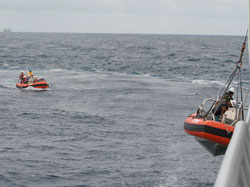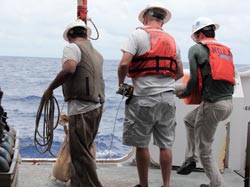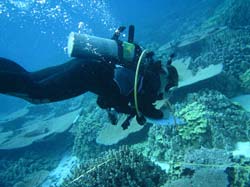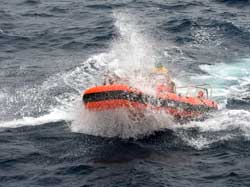
Reef Assessment and Monitoring Program Expediton Log – August 5, 2012
Water Logged!
By: Megan Onuma & Carlie Wiener, COSEE Island Earth

La Perouse in the background as day boats arrive back to the main ship from a day of field work. Credit: S. Freeman

Ship crew and scientists lower the deep water EAR (ecological acoustic monitor) into the water. Credit: C. Wiener
The 2012 Reef Assessment and Monitoring Program (RAMP) team finally arrived at French Frigate Shoals after three days of transit. Most of this location is largely submerged under water; however, there are a few spits of land – most famously Turn Island and La Perouse. As islands age, the mountains sink down into the ocean and eventually all that is left are a few low-laying sand islands and large coral reef that surround the area. "La Perouse", is a tall rocky islet within French Frigate Shoals, and ironically from a distance looks like a ship.
After many days on the ship, scientists were eager to get in the field and begin coral surveys and fish counts. Our dive operations are underway and we have spent three days diving in the North and South of French Frigate Shoals. The process to get in the field requires a lot of work from everyone on the ship. Scientists prep their dive gear and refine monitoring protocols, while the ship crew prepares the day boats. A large crane on the ship lifts the smaller day boats up off the deck and suspends them mid-air alongside the hull of the larger ship to be loaded. Those scientists going out for the day get on the boat as the crane lowers them down into the choppy seas. The small boats ferry the scientists to the dive sites, where they began their field work. Most of the research in the last few days has revolved around deploying acoustic monitors, and laying "transects" for observation. One of the acoustic monitors deployed is called an EAR (Ecological Acoustic Recorder). This particular device is suited for deep waters and was deployed off the side of the NOAA ship. It will be really interesting to see what sounds it picks up when the scientists come back next year to get it. It can record for up to a whole year automatically taking auditory snapshots of sound every 30 minutes.
One of the other projects has been the rapid ecological assessments (REA). This process of doing "transects" includes placing a long measuring tape along the bottom of the ocean next to a coral reef habitat, while the scientists swim alongside the tape recording the number of fish, algae, and coral species that they saw. This gives the researchers an idea of the variety and prevalence of species in an area. Monitoring the health of the coral reef ecosystem is important so managers can look at long-term trends over time. This is essential in remote and pristine marine ecosystems like the Northwestern Hawaiian Islands; and is the reason why this is one of the main focuses of this NOAA expedition.
Being out on the water provides such a unique experience for the scientists onboard. The coral habitats are unlike the Main Hawaiian Islands in that there are many more fish and coral to be seen. It is not uncommon to stumble across schools of sharks, ulua, turtles, and monk seals. Research teams have already been treated to many such encounters. This makes the long transit and hard hours at sea well worth the journey. The past few days have been rough seas with somewhat large swell. The transits in the small boats to and from the ship make for wet and bumpy rides. The beautiful scenery defiantly makes it worthwhile, oh and the hot meal waiting on the ship at the end of the day provides much comfort to the water-logged scientists too!
Click here to go back to the Expedition Log.


